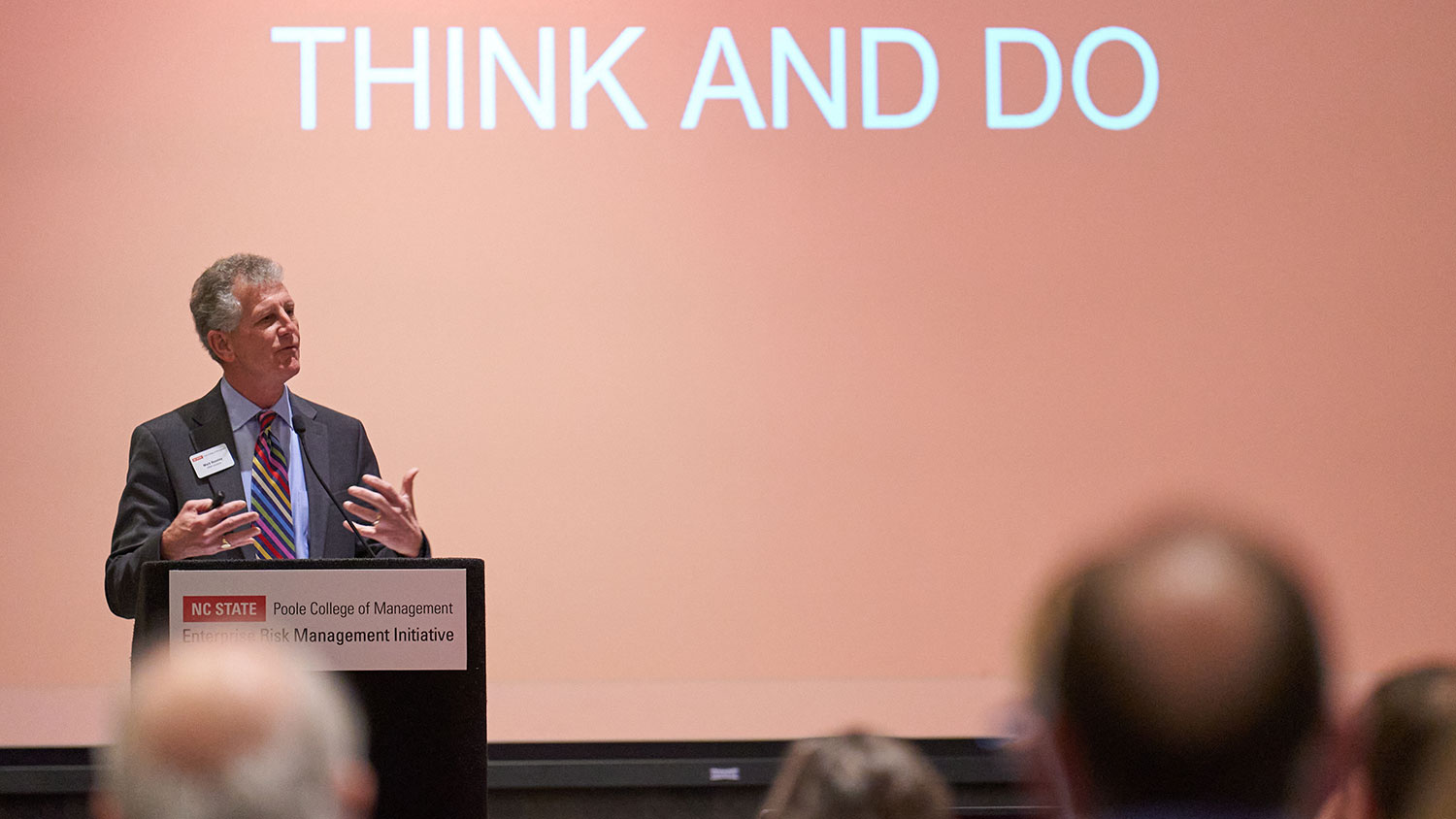ERM Roundtable Summit Addresses Reputational Risk, AI and Global Uncertainty
The biannual summit resources organizations with the latest data and best practices in risk management while also facilitating dialogue among risk management practitioners across a wide variety of industries.

By Samantha Beavers
When should companies take a public stand on political issues? How can risk practitioners get other business leaders to catch the vision about owning risk in their organization? What’s the risk of algorithm bias and how does that impact a company’s long-term investment in AI? These are just a few of the questions raised at the most recent Enterprise Risk Management (ERM) Roundtable Summit.
Hosted by Poole College of Management’s ERM Initiative at NC State, the biannual summit resources organizations with the latest data and best practices in risk management while also facilitating dialogue among risk management practitioners across a wide variety of industries. More than 100 attendees from 85 different organizations participated in the event — including the Coca-Cola Company, EY, the Bill and Melinda Gates Foundation, Walmart, RTI International, Children’s National Hospital, ExxonMobil and more.
“The ERM Roundtable is an excellent way to meet senior practitioners in the ERM field and see the real-life applications and challenges they are dealing with,” says Athena Theodorakis, a graduate student in the Master of Management, Risk and Analytics (MRA) program who attended the event. “ERM processes can vary a lot between companies, so it was really beneficial to hear from different speakers about the particulars of their ERM processes and some of the drivers for how they have evolved.”
Navigating Global and Reputation Risk
Chris Berger, head of global employee acquisition and experience for Royal Caribbean Group, kicked off the summit by discussing his experience navigating risks across a global workforce.
“I want to tell you about my impeccable timing of joining a cruise line in January 2020,” Berger said, laughing, to open his presentation. Discussing the global nature of the organization, as well as the size and diversity of its operations, he highlighted the complexity of the human capital risk for Royal Caribbean – especially in the midst of the pandemic.
“The biggest challenge with risk is not identifying the risk, but putting it in a business context,” Berger said. “It’s determining whether or not it’s a risk for your particular business and your particular strategy. Does it actually matter to your business? What are you doing about it? And can you get the business to understand why it’s a risk and get them to own it? It’s all about the context.”
“The ERM Roundtable is an excellent way to meet senior practitioners in the ERM field and see the real-life applications and challenges they are dealing with.”
Erin Rath Moos, vice president of enterprise risk and reputation for Target, followed Berger by providing insights about managing reputational risk. As a consumer-facing brand, Moos says, Target has faced several reputational challenges — especially in the midst of a politically volatile year.
To manage this reputational risk, Target engages in scenario planning, monitors legislation and current events, keeps employees up to speed on emerging risk insights and leans into its guiding principles. Additionally, the company regularly assesses the various expectations of team members, guests and stakeholders.
“We spend a lot of time thinking about the expectations of others — not that we have to meet all of them, but we have to understand them,” Moos said. “It’s been a long year and it’s going to be a longer year coming up, but what we’ve built will serve and prepare us well for what’s ahead.”
Stephanie Jackson, another MRA graduate student who attended the summit, found Moos’ comments to be particularly insightful — especially in light of her recent coursework.
“In class that week, we were asked to provide a response about whether or not CEOs should comment publicly on politically contentious topics. One thing [Moos] shared stuck with me. She said that before Target responds publicly, they think it’s important to pause and make sure that the response is in line with their guiding principles — and that they are prepared for handling any misinformation, as well as the potential impact to employees, customers and stakeholders,” Jackson says.
Integrating Risk and Strategy
In the third presentation, Peter WT Pisters, president of University of Texas’s M.D. Anderson Cancer Center, and Kate Kraycirik, vice president and chief risk officer of M.D. Anderson Cancer Center, discussed the vital role that risk management plays in the organization.
According to Pisters, 50% of cancers could be prevented today simply by employing the latest scientific information — which makes organizational resilience so essential. For this reason, M.D. Anderson focused on developing a risk program that aligns with its strategic plan, drives decision-making in a practical way and helps the organization maximize its impact on humanity.
“I really enjoyed hearing them speak and take us through how they developed their organizational strategy and ERM process — especially how they engaged the broader organization in the strategy development process,” Theodorakis says.
“My experience has been in operations, not finance or legal, which are the functions that traditionally oversee ERM processes — so it was particularly interesting to hear Dr. Pisters’ perspective as an operational executive and how his experience at his prior organization shaped his view of his role as CEO — and how that shaped M.D. Anderson’s strategy and ERM processes.”
Pisters and Kraycirik also discussed some of the organization’s top strategic risks, such as regulatory changes and volatile economic conditions, change fatigue, translational medicine, cybersecurity and AI. Pisters noted that while AI is one of M.D. Anderson’s top risks, it’s also one of its top opportunities. For example, AI can significantly reduce the amount of time doctors spend capturing notes from their private conversations with patients — which illustrates why it’s so important for the organization to have a shared understanding of its risk tolerances and to have a holistic picture of the risk.
“Having to do 35 minutes of computer time for every patient can take a lot of the joy out of medicine,” Pisters explained. “Using AI basically turns 35 minutes into 35 seconds — and it’s totally transforming clinical medicine in ways we can’t even imagine.”
Advancing Thought Leadership
After a networking lunch and table discussion about ERM challenges and solutions, Brenda Boultwood, director of the office of risk management at the International Monetary Fund, spoke about anticipating emerging uncertainties.
Robert Dunn, senior vice provost for University Interdisciplinary Programs at NC State, gave a final presentation about the future of the world — using insights from evolutionary biology to frame his discussion. Frank Buckless, dean of Poole College of Management, then closed out the summit with a summary of key insights from the presentations.
“It was extremely valuable to hear from risk experts, gain exposure to different examples of real-world practice and learn more about the top risks companies are currently facing. Some of my personal takeaways were that there needs to be a strong tone from the top about the importance of assessing risk and the role this plays in the company’s overall strategy — and that having regular, intentional communication with key personnel about risk, whether that’s with a risk committee, audit committee, or task force, is essential.”
- Categories:


